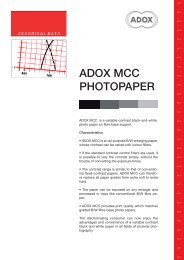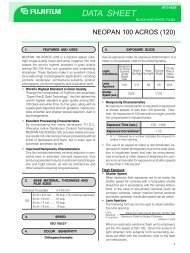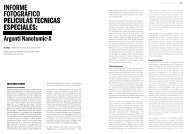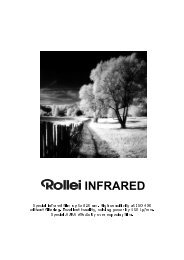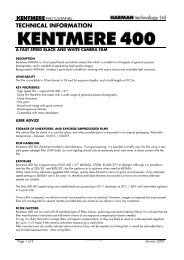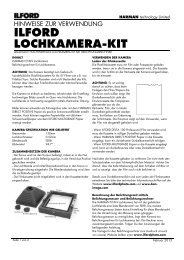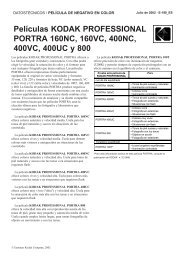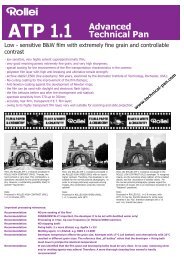EUROPE - Foto-R3
EUROPE - Foto-R3
EUROPE - Foto-R3
You also want an ePaper? Increase the reach of your titles
YUMPU automatically turns print PDFs into web optimized ePapers that Google loves.
© Erik Hattrem | KOMPRESSOR STUDIO | MOLDE | NORWAY<br />
Made in<br />
<strong>EUROPE</strong><br />
RPX<br />
100<br />
MACO PHOTO PRODUCTS - www.mahn.net - photo@mahn.net
TECHNICAL DATA<br />
ROLLEI RPX 100<br />
A) Description:<br />
Traditional medium speed black and white film.<br />
A good choice for a variety of photographic and scientific applications.<br />
Portrait, nature, architecture and product photography.<br />
Key properties:<br />
General indoor and outdoor photography applications.<br />
Fine grain.<br />
Enables good sharpness.<br />
Broad tonal range with good contrast.<br />
Broad exposure latitude.<br />
Compatible with many developers.<br />
Panchromatic sensitised.<br />
Sensitised from 380 to 660 nm at 2.850K<br />
B) Availability:<br />
In 135 size on a 0.120 mm acetate base.<br />
In 120 size on a 0.102 mm acetate base.<br />
135-24 + 135-36: 2 rolls packed in light-tight and high class twin packs. 35 mm long rolls on core.<br />
120: 1 roll in light-tight and high class roll film container.<br />
Sheetfilm is not available.<br />
C) Storage and Handling:<br />
Load and unload your camera in subdued light.<br />
The expiry dates according to a storage at 18°C / 64.4°F and standard humidity.<br />
Storage in the fridge at 8°C / 46.4°F doubled the expiry date.<br />
To freeze and storage the film at –18° / -0.4°F the life time can be about 10 years.<br />
For best results, process film as soon as possible after exposure.<br />
Please avoid storage temperatures more than 40°C / 104°F.<br />
D) Lighting Conditions:<br />
Light Sand, Snow, Bright Sun Lens Opening f/16 Shutter speed 1/250<br />
Bright Sun Lens Opening f/11 Shutter speed 1/250<br />
Hazy Sun Lens Opening f/8 Shutter speed 1/125<br />
Overcast Lens Opening f/8 Shutter speed 1/125<br />
Heavy Overcast Lens Opening f/5,6 Shutter speed 1/125<br />
E) Filter-Factors:<br />
RPX can be used with all standard types of filters. (No infrared – For this applications Rollei-Film offers<br />
superpancromatic films). Filter manufacturers do usually indicate what correction factor will be needed.<br />
F) Safelight:<br />
Handle unprocessed film in total darkness. Using a safelight will affect your results.<br />
An exception are spezial infrared filters, used for film production. (manufacturer on request)<br />
G) Processing:<br />
Factory speed has to be determined international in combination with Kodak D-76 developer.<br />
This is no recommendation, it is in order to make the different emulsions of the different producers comparable.<br />
Developers like Ilford Microphen doubeled the factory speed without loss of quality.<br />
Developers like Rollei RLS or Ilford Perceptol increases the quality of tonal range significant.<br />
This will affect the rated speed. In this case, RPX rated at 50 ISO.<br />
MACO PHOTO PRODUCTS - www.mahn.net - photo@mahn.net
H) Development Times:<br />
Agitate continuously for the first 30 seconds, than at 30-second intervals for the rest of the development time.<br />
Standard: 20°C / 68°F<br />
Developer Dilution Meter-setting:<br />
50/18° 100/21° 200/24°<br />
Agfa/compard<br />
Rodinal R09 OS 1+25 7 9 13<br />
1+50 - 18 20 ½<br />
Rodinal Spezial 1+15 - 3 ½ -<br />
BKA<br />
Diafine - - 3+3<br />
Acu 1 1+10 - 9 10 ½<br />
Champion<br />
Promicrol 1+9 - 6 -<br />
1+14 - 9 -<br />
Ilfotec DD-X 1+4 9 11 13<br />
Ilfosol S 1+9 5 ½ 7 ½ 8 ½<br />
Ilfosol 3 1+9 - 5 -<br />
1+14 - 7 ½ -<br />
Ilfotec HC 1+15 - 4 ½ 5 ½<br />
1+31 5 ½ 7 8 ½<br />
Ilfotec LC29 1+19 6 7 ½ 8 ½<br />
1+29 7 ½ 11 -<br />
ID-11 Stock 7 9 11<br />
1+1 9 12 16<br />
1+3 18 - -<br />
Microphen Stock - 9 9 ½<br />
1+1 - 11 15<br />
Perceptol Stock 10 13 -<br />
1+1 14 16 -<br />
Kodak D-76 Stock 6 ½ 8 ½ 10<br />
1+1 8 11 15<br />
1+3 17 20 -<br />
Kodak T-Max 1+4 - 4 ½ 9<br />
Kodak T-Max RS Stock - 5 -<br />
HC 110 (A) - 4 ½ 6<br />
HC 110 (B) 6 7-9 12<br />
XTOL Stock 6 ½ 8 -<br />
(1:1) 8 ½ 10 -<br />
Microdol X Stock 10 15 -<br />
(1:3) 17 23 -<br />
Paterson FX39 1+9 - 7 ½ -<br />
Rollei RHS 1+15 - 5 ½ -<br />
Rollei RLS 1+4 (24°C) 10 - -<br />
Spur HRX-3 1+29 5 ½ - -<br />
SD2525 1+15 5 - -<br />
SLD 1+9 - 3 ½ -<br />
Recommendations for FILM PROCESSING<br />
Preparations<br />
(Some advice from a practitioner, not only for beginners) Exposed films should be processed as swiftly as<br />
possible. The stability of the latent image of standard b&w films is not as problematic an issue as that of colour<br />
films. The latent time of fast, and particularly of IR films should be kept as short as possible.<br />
LABOR PARTNER exclusively offers liquid concentrates. These can be diluted in the laboratory. Where powder<br />
chemicals are to be used, these should be mixed outside the laboratory as a matter of principle.<br />
If the darkroom is not absolutely dust-free, spraying the room with water is recommended. Water droplets act<br />
as dust scavengers. All items needed should always be stored at the same places.<br />
Prewashing<br />
Some film manufacturers advise against prewashing, others recommend it.<br />
The following is fact:<br />
Prewashing is permissible, but not necessary, with surface developers. With depth developers, prewashing is<br />
always recommended. Prewashing removes the anti-halation backing as can be seen from the blue or green<br />
colour of the water. This may, or may not, be an advantage. The swelling of the gelatine, however, is an<br />
advantage, as capillary action is enhanced. The action of the developing solution on the emulsion becomes<br />
more uniform.<br />
MACO PHOTO PRODUCTS - www.mahn.net - photo@mahn.net
Preparation of developer<br />
Bring tap water to the proper temperature. Fresh tap water may contain large quantities of oxygen and<br />
chlorine. This disadvantage is avoided by leaving the required quantity of water to stand for a night.<br />
Decide on whether or not you intend to use the developer hardener LP-GELADUR.<br />
First prepare precisely the required quantity of water.<br />
Then measure the required quantity of developer concentrate, and add it to the water.<br />
Mixing should not be too vigorous, as the generation of air bubbles shall be avoided at any rate. Some lab<br />
workers tap down the developing tank to dislodge any air bubbles from the film, which might otherwise register<br />
as circular white spots.<br />
DEVELOPMENT (35-mm and medium format roll films)<br />
The film reels having been inserted and the tank safely closed, the developer working solution is poured in. Try<br />
to avoid generating air bubbles during this step, too. Start counting down the selected time on the lab timer,<br />
and regularly invert the tank for 30s.<br />
Later, invert once every 30s for as long as the film takes.<br />
Where the developer requires working at elevated temperature, let the tank sit in a developing tray filled with<br />
water at the right temperature. This is also recommended where room temperature significantly deviates from<br />
the processing temperature.<br />
Stop bath<br />
As soon as the developer has been swiftly poured out of the tank, either briefly rinse the tank, or immediately<br />
pour in the stop bath.<br />
The stop bath, either LP-CITRIN or LP-CITRODUR is filled in swiftly. Make sure that the temperatures of the<br />
baths following the developer do deviate considerably from the developer temperature. The stop bath working<br />
solution remains in the tank for approximately half a minute, or a minute. Invert regularly during this time.<br />
Stop bath is relatively inexpensive, so it should be used one-shot.<br />
Fixing<br />
Just like the change from developer to stop bath, pour swiftly again. Here, too, invert permanently during the<br />
first 30s, then once every 30s, for as long as the film takes to fix.<br />
Fixers are of utmost importance for the results, and for the permanence of the finished film.<br />
Never use the same fixer working solutions for films and papers.<br />
The only acceptable exception would be using film fixer for RC papers.<br />
Washing<br />
The film remains in the reels. Don’t take it out of them.<br />
We are now approaching that stage of film processing which often gives disappointed lab workers faulty results.<br />
This is because the “other baths” are not given the same attention as the developer. Washing requires as much<br />
attention as developing and fixing.<br />
Rather often, tanks are connected to hoses by which fresh tap water is injected into the tank. A very daring<br />
method! Over- and undertemperature are possible, emulsion peeling or reticulation may be the consequence.<br />
For archival results, use the following washing procedure:<br />
Prepare a bucket of water, as much as you may need, the day before you process a film. Often, the water will<br />
then have the right temperature when you need it, and if not, this larger quantity is much easier to get to, and<br />
hold at, the right temperature.<br />
How much will you need?<br />
Let us assume 260 ml of solution for one 35-mm film. The fixer working solution having been poured out of the<br />
tank, swiftly fill in 260 ml of the water prepared the evening before. The tank is then inverted regularly for one<br />
minute.<br />
Pour out the water, refill. The tank is then inverted regularly for two minutes. 8 changes followed by 2 minutes<br />
of regular agitation each ensure optimised, i.e. archival washing.<br />
Wetting agent/drying<br />
The film still remains in the reels. Don’t take it out of them. Following the washing, a special wetting agent<br />
treatment is mandatory. As the ninth washing bath, pour the wetting agent solution, prepared with<br />
demineralised water (or Aqua Dest., or battery water from the gas station or drugstore), into the tank. Again,<br />
invert regularly, but not hectically.<br />
When the wetting agent solution has been poured out of the tank (do not keep it, it’s for one-shot use only),<br />
take the film out of the reels with utmost diligence, and attach a film hanger. The film should be hung in a dry,<br />
dust-free, and draught-free environment. Attach a weight to the bottom end for the film to dry flat. If you can<br />
dry the film in a drying cabinet, switch on the fan, but not the heating. Only then will the film dry uniformly and<br />
without drying marks. Avoid any mechanical manipulation, squeegees, leather; pulling the film through your<br />
fingers is not a good idea. Such items were probably thrown on the market by sales people who have never<br />
developed a film themselves. Flatness of the film after drying is particularly difficult to achieve with films on a<br />
polyester base. Especially for these, the lab worker should use special LP-MASTERPROOF.<br />
Archival/storage of processed film<br />
For longterm archiving of the developed films we recommend negative sleeves and archival albums, which<br />
existed the P.A.T (Photographic Activity test) test.<br />
These items can be purchased in specialized shops and in our online shop www.macodirect.de.<br />
MACO PHOTO PRODUCTS - www.mahn.net - photo@mahn.net
CHEMICAL PROTECTION<br />
Films are easily scratched, marked by fingerprints, or damaged by humidity.<br />
There are several means of protecting films. Chemical protection is achieved by hardening of the emulsion by<br />
means of a hardener to be added to the developer. This may be news to quite a number of photographers/lab<br />
workers, but the method has been known under the heading “tropical developer” for a long time. An additive<br />
was mainly used for machine development, although it was not realised that it was a hardener, because it was<br />
just one part in many.<br />
So GELADUR is not a new development by LABOR PARTNER, but learning from history.<br />
Hardening stop baths are also common. Or hardening fixers. But what’s the use of protection at later<br />
processing stages if the emulsion is already damaged in the developer?<br />
Author: Hartmuth Schroeder<br />
November 2010<br />
HANS O. MAHN GmbH & CO. KG<br />
MACO PHOTO PRODUCTS<br />
Brookstieg 4; D-22145 Stapelfeld/Hamburg<br />
Tel.: +49 (0) 40 237008-88<br />
Fax: +49 (0) 40 237008-488<br />
Email: photo@mahn.net<br />
Web: www.mahn.net<br />
Email: info@rolleifi lm.de<br />
Web: www.rolleifilm.de<br />
LICENSE HOLDER AND PRODUCER OF ROLLEI FILMS, PAPER AND CHEMISTRY.<br />
MACO PHOTO PRODUCTS - www.mahn.net - photo@mahn.net




